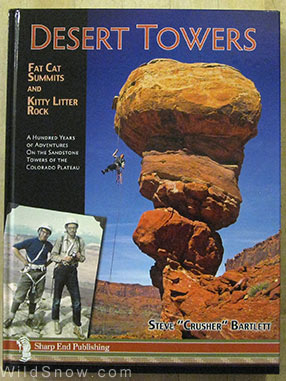
Desert Towers backcountry rock climbing book.
Climbing is like art. You know it has a place, but it also seems so pointless, even ridiculous at times.
If any form of climbing reaches the height of absurdity while at the same time rising to the level of creative genius, it has to be the rock work done in the great Southwest Desert of the United States. Specifically, the area defined by the higher altitude “Colorado Plateau” that covers the southeast corner of Utah, extending west into Colorado and south into Arizona and New Mexico.
Sure, the great walls of Yosemite are a pallet for vertical artists, as are the alpine climbs of the Cascades or the epics of Alaska. And so on.
But there is something about desert towers… Perhaps it’s the way they look, every one so unique in shape and texture — some hearkening to gargoyles or witches, others obviously caricatures of priests and nuns. Perhaps it’s the rock, frequently terrible and demanding the most from the climber. Perhaps it is just the place, the desert, where it gets so quiet you can hear the blood in your ears singing your song.
Thus, it was with profound joy and excitement that I ripped open the box containing Crusher Bartlett’s new tome “Desert Towers,” a 352 page large-format book that documents the last century of tower climbing on the Colorado Plateau. Profusely illustrated with hundreds of digitally re-mastered historic photos, Crusher’s book is so complete, so voluminous and so compelling I’m having a hard time dealing with it.
I find myself trying to start reading from the beginning of the book, only to randomly crack it open to see what amazing photo or essay will leap out at me. There, just now, I go for page 34, a beautiful double page photo of a guy on the summit of Shiprock, with the barren but somehow tasty desert extending beyond and below like the view from a passenger jet. Or how about page 137, where you see legendary climber Layton Kor involved in one of the time honored traditions of desert climbing; that of doing road improvements to get your 2×2 low clearance street rig close enough to the climb so you don’t have to man-haul your beer stash (in this case the vehicle is a 1950s vintage Ford Falcon station wagon).
You can even find yours truly in there, with my essay about our first ascent of the Titan west face back in 1973. The story involves rappelling in the dark, wrapping myself with a rope to stay warm while bivouacking in a t-shirt, and other fine desert traditions.
My contribution is tiny. What stands out is the huge amount of content Crusher has gathered from the masters and pioneers of the desert. He’s got a ton of stuff in there about Layton Kor, who started the whole thing. And of course legendary Harvey Carter, who kept it going through some lean years when most guys wanted to avoid being coated with mud and instead do wimpy things like Yosemite wall climbs. Crusher even includes some how-to tips and gear history (some of the gear and techniques developed in the desert are quite unique.)
Take my word for it, this stunning unique book will not disappoint. Indeed, even a non-climber who’s interested in sport history and athletics would probably find it compelling. Shoot, just the photos of manly men in knicker pants are worth the price of admission. Christmas gift? Available at climbing shops, online availability information is coming. Published by Sharp End Publishing.
WildSnow.com publisher emeritus and founder Lou (Louis Dawson) has a 50+ years career in climbing, backcountry skiing and ski mountaineering. He was the first person in history to ski down all 54 Colorado 14,000-foot peaks, has authored numerous books about about backcountry skiing, and has skied from the summit of Denali in Alaska, North America’s highest mountain.
